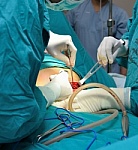The growth process of a baby in the womb – How does the baby grow inside the womb of the mother. Remember a woman who fails to take care of herself during pregnancy is less likely to give birth to a healthy baby.
The growth process of a baby in the womb explained in detail
The small bundle of cells implanted in the wall of the womb, are differentiated in the first three weeks into two major groups.
The first group forms in due course, arms and legs, and heart and lungs. The second group forms part of the umbilical cord that joins the foetus to the placenta, popularly known as the afterbirths.
The latter is a saucer-shaped mass of blood vessels and soft tissue. It is through this that the foetus obtains its nutrition from the mother. It also provides certain hormones for the maintenance of the pregnancy.
As the foetus approaches fourth week, a head, a trunk and arms and legs have already developed. It remains encased in a waterproof membrane. The water in the case keeps the baby protected from outside shock and also keeps it warm.
The sixth week shows development of remarkable features. The embryo measures about an inch in length and weighs 1/30th of an ounce.
It has taken the shape of a human face with eyes, nose, ears, lips and tongue and buds of milk teeth buried in the minute gums.
Muscles, skin and a soft skeleton as also a tiny brain and heart with minute blood vessels are there. The stomach has begun to produce the digestive juices.
At the end of the eighth week, external sex organs show up. However, it is nearly impossible to make out the baby’s sex from the appearance of these ambiguous organs.
Between 16 and 24 weeks the baby’s heartbeat can be heard by a doctor.
By the end of 24th week, the foetus is around 12 inches in length. Its weight is about 1.5 pounds. In a healthy woman, it should increase its weight nearly five times in the last trimester of pregnancy.
It is during this period that the mother may become increasingly conscious of the baby “kicking” and thumping – to the extent of exhausting the mother – the higher the chances of the baby growing into an active adult who will always be on the move.
It is during these last 12 weeks that the baby attempts sucking his fingers. He may attempt to cry as well, without producing a sound.
Antenatal check-up
As soon as a woman becomes aware of the pregnancy (or even suspects it), she should have an antenatal check-up and then follow it regularly throughout the pregnancy.
At the first antenatal check-up, the doctor would like to have the pregnant woman’s medical history, make a physical examination and do a few tests.
He may ask about the present and past state of your health, as also about your earlier pregnancies (if any), the family history, your diet and the like.
Sitting over some information that may have a bearing on the course or outcome of pregnancy may well prove dangerous. The doctor needs your full cooperation.
A thorough physical examination includes examination of the birth passage (the pre-vaginal examination) and checking the blood pressure (BP). It is also important to make a record of the weight and height.
The doctor may also like to have certain measurements of the pelvis, the bony cage through which the baby will ultimately pass during delivery.
The laboratory tests which the doctor would like to carry out include:
blood examination for level of haemoglobin to ascertain if anaemia is present and for blood grouping (particularly if Rh is positive or negative),
urine examination for pus cells and albumin (a protein) and stool examination for eggs of intestinal parasites such as roundworm, bookworm, giardia and amoeba.
If your obstetrician suspects foetal abnormalities, he may like to do such sophisticated investigations such as –
Alpha-fetoprotein (AFP)
Chorionic villus sampling (CVS)
Amniocentesis
Abdominal ultrasound
You should attend the antenatal clinic (or perhaps your obstetrician can do it at your own place) once a month until the seventh month.
After the seventh month such a check-up should be once in a fortnight. During the ninth month, it should be every week until delivery.
At the time of antenatal check-ups, the would-be mother should discuss with the doctor any emotional problems or apprehensions (about the pregnancy) she may have, which may be causing undue tension.
It is not just your physical health that is important, you should be healthy emotionally too.
Most pregnancies with good antenatal care would end up happily. Yet the pregnant woman should remain vigilant and alert.
Report to your doctor if the morning sickness is severe and adamantly persistent, or there is any vaginal bleeding, swelling of feet and ankles, blurring of vision, persistent headache/giddiness, leaking of water from womb or cessation of foetal movements.
RELATED TOPICS
Personal trainer certification
Personal injury lawyers in Phoenix
Online medical assistant schools

